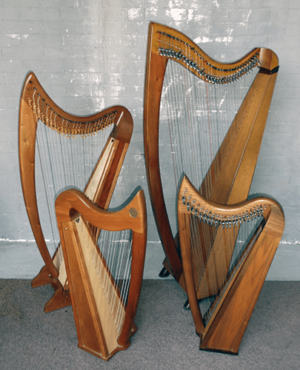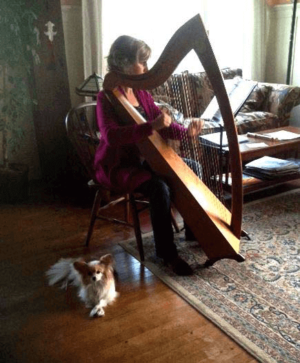By Susan Beal
 I just returned from a folk harp festival, a sort of Brigadoon for harp players, who come from all around the country and several other parts of the world to learn, teach, talk and play folk harp. Not many people play folk harp, and none at all play it where I live. The harp is a bit exotic and has characteristics that can present challenges when playing with other musicians. So the chance to be amongst other passionate harp players is a bit like the ugly duckling meeting swans for the first time. There’s a sense of familiarity and belonging that brings great joy whenever people come together over a shared passion.
I just returned from a folk harp festival, a sort of Brigadoon for harp players, who come from all around the country and several other parts of the world to learn, teach, talk and play folk harp. Not many people play folk harp, and none at all play it where I live. The harp is a bit exotic and has characteristics that can present challenges when playing with other musicians. So the chance to be amongst other passionate harp players is a bit like the ugly duckling meeting swans for the first time. There’s a sense of familiarity and belonging that brings great joy whenever people come together over a shared passion.
Workshops at the festival spanned every harp-related topic imaginable. Among the ones I took were two led by a woman I have admired from afar for many years, a luminary in the Celtic folk harp tradition who almost single-handedly rescued the Irish harp tradition from oblivion. Getting to meet her was like getting to meet Santa Claus.
There was an exhibition hall filled with harps in all shapes and sizes, from towering pedal harps with 47 strings, to tiny, 15 string lap harps that seemed like the harp version of ukuleles. And because everyone was trying out harps, the hall was filled with the thrumming, chaotic, melodious resonance of dozens of harps being played all at once. The concerts at night featured an amazing lineup of performers in various traditions from around the world – Celtic, Turkish, Jewish, Paraguayan, and one performer who rocked out on electric harp. So many interpretations of an instrument most people associate with angels on clouds!
It was heaven for harp players, right there in New Jersey.
It's easy to understand why harps are associated with angels and heaven. The harp is unique in the number of open strings it has—more than any other instrument but the piano—that vibrate sympathetically whenever any strings are played. It creates layers of harmonic frequencies that evoke the higher worlds and the harmony of the spheres. Research shows that such frequencies have powerfully healing effects, but we don’t need science to tell us what our bodies already know. Music is healing.
Celtic legends are filled with stories of harps being used to invoke magic and summon magical beings, or to open portals to the faery realms. Ancient harpers believed that harps themselves were alive, and people treated them as more than mere instruments. They were beings in their own right.
I’d wanted to play Celtic harp since 1981 when I got a cassette tape of a man named Patrick Ball playing a wire strung harp. But back then folk harp was a rare thing. Playing it seemed unattainable, the harp more a myth than part of my world, like the land of the Sidhe. Through the years I told myself it wasn’t practical, and I should focus on the instruments I already played, namely trumpet, oboe and guitar.
But once I began playing the harp, I realized all those other instruments were the flings I had in search of my soul mate. The synchronicities that unfolded hinted that something larger was at work. I’d been in a very difficult period for several years and my heart felt desiccated and broken. I’d had severe insomnia for a long time, and wondered if I’d lost the capacity for happiness as well as for sleep. Then I went to a concert at my son’s college, and one of the students played a small Celtic harp. The tune he played was “My Heart Will Go On,” the theme song from the movie Titanic. The sound was like a quenching rain to the cracked desert of my heart, and I started to feel things I hadn’t allowed myself to feel in years. It revived the longing I’d felt 30 years before, whenever I listened to the cassette tape. I realized this renewed yearning was about more than learning to play the harp. It was about learning to listen to my own heart, no matter how impractical it might seem.
 The first harp I got, a 22 string I found on Craig’s List, was called an Eve by its maker, a fitting name for giving in to the temptation I had denied for decades. My family of harps has grown since then—and, interestingly, the double strung harp I just brought home is also an Eve. I’ve always understood the story of Adam and Eve as being about the courageous step we humans took in descending deeply into matter, taking on material bodies while our angelic and faery cousins stayed in the more ethereal, Edenic realms.
The first harp I got, a 22 string I found on Craig’s List, was called an Eve by its maker, a fitting name for giving in to the temptation I had denied for decades. My family of harps has grown since then—and, interestingly, the double strung harp I just brought home is also an Eve. I’ve always understood the story of Adam and Eve as being about the courageous step we humans took in descending deeply into matter, taking on material bodies while our angelic and faery cousins stayed in the more ethereal, Edenic realms.
The fact that it is told as a story of wrongdoing and punishment betrays the difficulties of living in and between two worlds—heavenly and earthly. Our dense, material bodies allow us to experience Earth in ways our celestial counterparts can’t, but they also seduce us into forgetting we’re more than material beings. It’s a constant balancing act to synthesize opposites, and we’d do well to cut ourselves some slack when we mess it up.
Perhaps that challenge explains, in part, the power of the harp to soothe and heal. Like us, the harp has to balance opposing forces. We couldn’t hear the vibrating strings without the wooden body of the harp to act as a resonator. The soundbox of the harp has to be strong enough to withstand the tremendous tension of the strings, and the strings have to be tight enough to vibrate in the correct pitch. If the string tension is too great, the harp breaks. If the strings are too loose, the sound is dull and out of tune. When they work together, they transform the elements of wood, metal, air, and the fire of creativity, into beautiful music. That’s magic.
I have learned so much from learning to play the harp, not the least of which is the power of the music to bring heaven and earth together, and the joy to be had when one listens to one’s heart.
Questions or comments to share? Please email drenag@lorian.org.
